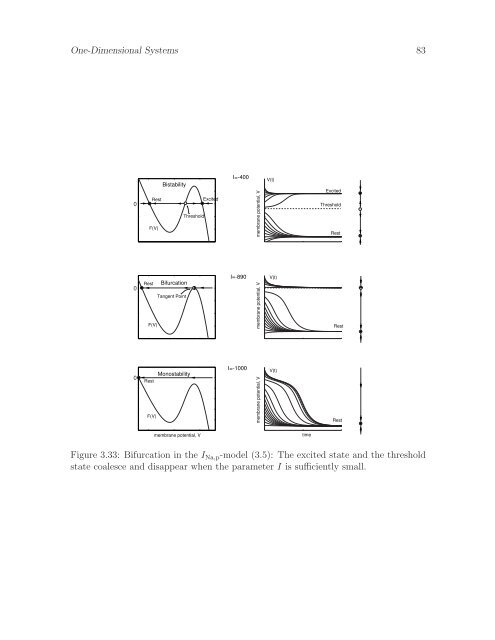Dynamical Systems in Neuroscience:
Dynamical Systems in Neuroscience: Dynamical Systems in Neuroscience:
82 One-Dimensional Systemsmembrane potential, V (mV)40200-20-40-60-80-100-120excited statesthreshold statessaddle-node(fold) bifurcationrest statessaddle-node(fold) bifurcationI (V)16-890membrane potential, V (mV)40200-20-40-60-80-100-120-1000 -500 0injected dc-current, I (pA)-1000 -500 0injected dc-current, I (pA)Figure 3.32: Bifurcation diagram of the I Na,p -model (3.5).the phase portrait of the system, as we illustrate in Fig. 3.32, right. Each point wherethe branches fold (max or min of I ∞ (V )) corresponds to a saddle-node bifurcation.Since there are two such folds, at I = 16 pA and at I = −890 pA, there are two saddlenodebifurcations in the system. The first one, studied in Fig. 3.25, corresponds to thedisappearance of the rest state. The other one, illustrated in Fig. 3.33, correspondsto the disappearance of the excited state. It occurs because I becomes so negativethat the Na + inward current is no longer strong enough to balance the leak outwardcurrent and the negative injected dc-current to keep the membrane in the depolarized(excited) state.Below the reader can find more examples of bifurcation analysis of the I Na,p - andI Kir -models, which have non-monotonic I-V relations and can exhibit multi-stabilityof states. The I K - and I h -models have monotonic I-V relations and hence only oneequilibrium state. These models cannot have saddle-node bifurcations, as the readeris asked to prove in Ex. 13 and 14.3.3.8 Quadratic integrate-and-fire neuronLet us consider the topological normal form for the saddle-node bifurcation (3.9). From0 = I + V 2 we find that there are two equilibria, V rest = − √ |I| and V thresh = + √ |I|when I < 0. The equilibria approach and annihilate each other via saddle-node bifurcationwhen I = 0, so there are no equilibria when I > 0. In this case, ˙V ≥ I and V (t)increases to infinity. Because of the quadratic term, the rate of increase also increases,resulting in a positive feedback loop corresponding to the regenerative activation ofNa + current. In Ex. 15 we show that V (t) escapes to infinity in a finite time, whichcorresponds to the up-stroke of the action potential. The same up-stroke is generatedwhen I < 0, if the voltage variable is pushed beyond the threshold value V thresh .
One-Dimensional Systems 8300BistabilityRestExcitedThresholdF(V)Rest BifurcationTangent PointF(V)I=-400I=-890membrane potential, V membrane potential, VV(t)V(t)ExcitedThresholdRestRest0RestF(V)MonostabilityI=-1000membrane potential, VV(t)Restmembrane potential, VtimeFigure 3.33: Bifurcation in the I Na,p -model (3.5): The excited state and the thresholdstate coalesce and disappear when the parameter I is sufficiently small.
- Page 42 and 43: 32 Electrophysiology of NeuronsFigu
- Page 44 and 45: 34 Electrophysiology of Neuronsm (V
- Page 46 and 47: 36 Electrophysiology of Neurons10.8
- Page 48 and 49: 38 Electrophysiology of Neurons2.3
- Page 50 and 51: 40 Electrophysiology of NeuronsFigu
- Page 52 and 53: 42 Electrophysiology of NeuronsDepo
- Page 54 and 55: 44 Electrophysiology of NeuronsV(x,
- Page 56 and 57: 46 Electrophysiology of Neurons1m (
- Page 58 and 59: 48 Electrophysiology of NeuronsPara
- Page 60 and 61: 50 Electrophysiology of NeuronsFigu
- Page 62 and 63: 52 Electrophysiology of Neuronsvolt
- Page 64 and 65: 54 Electrophysiology of Neurons
- Page 66 and 67: 56 One-Dimensional SystemsActivatio
- Page 68 and 69: 58 One-Dimensional Systemsinwardcur
- Page 70 and 71: 60 One-Dimensional Systems40bistabi
- Page 72 and 73: 62 One-Dimensional Systemsat every
- Page 74 and 75: 64 One-Dimensional Systems?F(V)>0+
- Page 76 and 77: 66 One-Dimensional SystemsUnstableE
- Page 78 and 79: ¡ ¡ ¡¡ ¡ ¡¡ ¡ ¡¡ ¡ ¡¡
- Page 80 and 81: 70 One-Dimensional Systems+ - - + +
- Page 82 and 83: 72 One-Dimensional Systemsλ(V-Veq)
- Page 84 and 85: 74 One-Dimensional Systemsbifurcati
- Page 86 and 87: 76 One-Dimensional Systems100806040
- Page 88 and 89: 78 One-Dimensional Systemsbifurcati
- Page 90 and 91: 80 One-Dimensional Systems20 mV100
- Page 94 and 95: 84 One-Dimensional Systemssteady-st
- Page 96 and 97: 86 One-Dimensional Systemsspike rig
- Page 98 and 99: 88 One-Dimensional SystemsVF (V)1VV
- Page 100 and 101: 90 One-Dimensional Systems10.80.60.
- Page 102 and 103: 92 One-Dimensional Systems
- Page 104 and 105: 94 Two-Dimensional SystemsI Na,pneu
- Page 106 and 107: 96 Two-Dimensional Systemsdefines a
- Page 108 and 109: 98 Two-Dimensional Systems(f(x(t),y
- Page 110 and 111: 100 Two-Dimensional Systems0.70acti
- Page 112 and 113: 102 Two-Dimensional Systems0.70.6K
- Page 114 and 115: 104 Two-Dimensional Systemsy1.510.5
- Page 116 and 117: 106 Two-Dimensional SystemsFor exam
- Page 118 and 119: 108 Two-Dimensional SystemsIn gener
- Page 120 and 121: 110 Two-Dimensional Systemsv 2 v 2v
- Page 122 and 123: 112 Two-Dimensional SystemsV-nullcl
- Page 124 and 125: 114 Two-Dimensional SystemsV-nullcl
- Page 126 and 127: 116 Two-Dimensional Systemsheterocl
- Page 128 and 129: 118 Two-Dimensional Systems0.60.5n-
- Page 130 and 131: 120 Two-Dimensional Systemseigenval
- Page 132 and 133: 122 Two-Dimensional SystemsK + acti
- Page 134 and 135: 124 Two-Dimensional Systemsexcitati
- Page 136 and 137: 126 Two-Dimensional SystemsReview o
- Page 138 and 139: 128 Two-Dimensional SystemsabcdFigu
- Page 140 and 141: 130 Two-Dimensional SystemsFigure 4
One-Dimensional <strong>Systems</strong> 8300BistabilityRestExcitedThresholdF(V)Rest BifurcationTangent Po<strong>in</strong>tF(V)I=-400I=-890membrane potential, V membrane potential, VV(t)V(t)ExcitedThresholdRestRest0RestF(V)MonostabilityI=-1000membrane potential, VV(t)Restmembrane potential, VtimeFigure 3.33: Bifurcation <strong>in</strong> the I Na,p -model (3.5): The excited state and the thresholdstate coalesce and disappear when the parameter I is sufficiently small.



